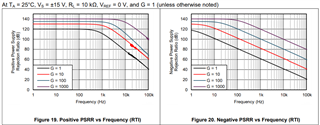Hi Team,
Can we use switching power supply to power the INA828? Or would you recommend us to use an LDO instead?
The INA828 has good PSRR so I would think switching power supply should be fine. Am I right?
Thanks!
Roy
This thread has been locked.
If you have a related question, please click the "Ask a related question" button in the top right corner. The newly created question will be automatically linked to this question.
Hi Team,
Can we use switching power supply to power the INA828? Or would you recommend us to use an LDO instead?
The INA828 has good PSRR so I would think switching power supply should be fine. Am I right?
Thanks!
Roy
Hello Roy,
You are correct the INA828 does have very good PSRR, however the PSRR does roll-off over frequency as shown in figure 19 and 20 from the datasheet. Depending on your switching frequency and signal bandwidth, the PSRR alone may not be adequate.
What is your gain and signal bandwidth?
What switching frequency will be used for your power supply?

In either case, be sure to connect low-ESR, 0.1-µF ceramic bypass capacitors between each supply pin and ground, placed as close to the device as possible.
Thanks,
Zach
Hi Roy,
the supply voltage of an OPAmp should always be stable, clean and noisefree, even if the supply voltage rejection of OPAmp seems to be excellent. Keep in mind that at higher frequencies where the OPAmp reaches its bandwidth the supply voltage rejection becomes non-linear. This means that a sine wave at the supply voltage pins gets more and more distorted. Also, the small signal behaviour may differ from the large signal behaviour. So, while the OPAmp may suppress supply voltage noise at the lower frequencies very well, provided the noise does not exceed a certain critical level, the supply voltage rejection may (heavily) degrade at the higher frequencies, especially at those frequencies which are related to the switching ripple and sharp edges of a switching power supply.
Of course, a lot depends on the switching frequency, the harmonics and the nature of your switching power supply. But since it is very easy to properly filter out the switching noise of a switching power supply with the todays available ferrite beads and ceramic high caps, I would strongly recommend to mount a low pass filter (directly) at the output of your switching power supply.
If your switching power supply is a DC-DC-converter, then I heavily recommend to mount pi-filters directly at the input and the outputs of DC-DC-converter. With the todays filtering components you are able to filter out the switching noise nearly to any desired level. Then you don't need to use a special LDO but can use your DC-DC-converter.
The low pass filtering arround the switching power supply is not only important to keep the supply voltage lines as noisefree as possible but also to stop the switching noise from spreading arround into the environment. Only by consequent low pass filtering EMI can sufficiently be suppressed and your circuit is able to comply with the EMI standards at the end.
If the supply voltage of an OPAmp has to be filtered anyway, why an OPAmp needs a high PSRR? Because in an ultra low noise application -and the INA828 is designed for being used in such applications- the remaining supply voltage noise would otherwise be injected into the signal path and increase the signal noise. So, optimum performance can only be achieved with a stable, clean and noisefree supply voltage AND an OPAmp with a high PSRR. Sometimes, even RC-low pass filters are added at the supply voltage pins of OPAmps. Think of a microphone amplifier, for instance, or a moving magnet or even moving coil pre-amplifier, or similar.
Kai
Thank you for your insights on this Kai, this is very helpful.
I will add that when using power supply filtering in series with the supply, such as an RC filter, it is important to keep in mind the power dissipation within the filter. For a low-power device such as the INA828 this is less of a concern, but it could be a factor if the device is required to sink/source a high amount of current.
Thanks,
Zach